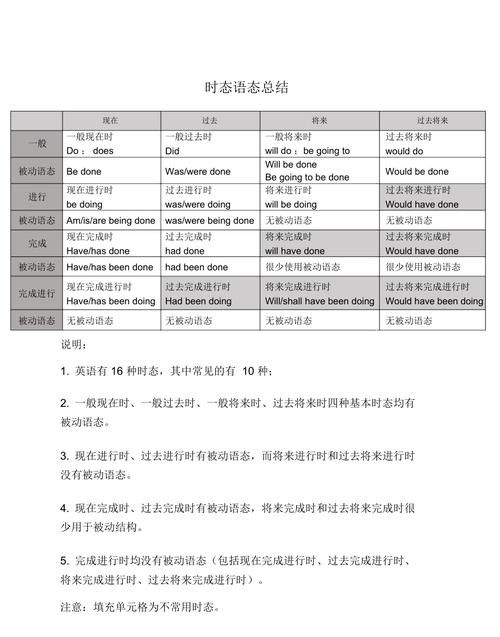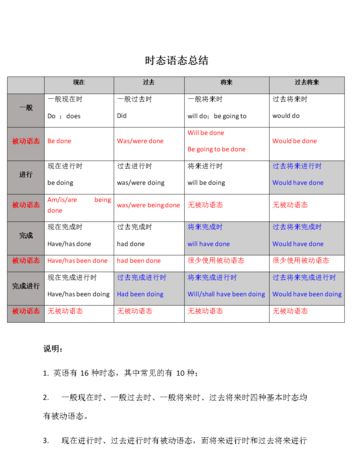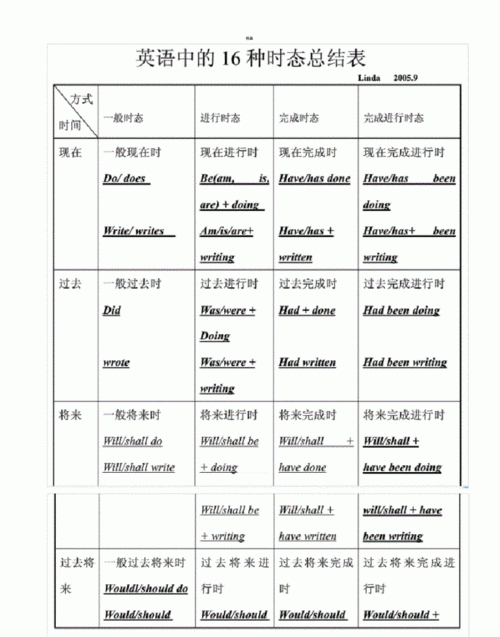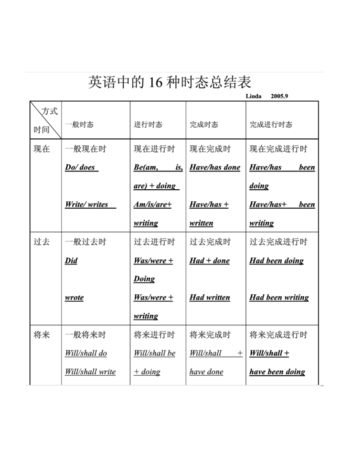本文目录
英语一共有多少种形态
英语时态分为16种:一般现在、一般过去、一般将来、过去将来时,以及这四者的进行时、完成时和完成进行时.
1. 一般现在时
用法:
A) 表示现在发生的动作、情况、状态和特征.
B) 习惯用语.
C) 经常性、习惯性动作.
例:He always helps others. (他总是帮助别人.)
D) 客观事实和普遍真理.尤其要注意,如果前后文不是一般现在时,则无法保持 主句、从句时态一致.
E) 表示一个按规定、计划或安排要发生的动作,(仅限于某些表示“来、去、动 、停、开始、结束、继续”等的动词 )可以与表示未来时间的状语搭配使用 .常见的用法是:飞机、火车、轮船、汽车等定期定点运行的交通方式.
例:The next train leaves at 3 o'clock this afternoon.
(下一趟火车今天下午3点开车.)
2. 现在进行时(be doing)
用法:现在正在进行的动作.she is dancing.
3. 现在完成时(have done)
用法:
A) 表示动作到现在为止已经完成或刚刚完成.
B) 表示从过去某时刻开始,持续到现在的动作或情况,并且有可能会继续延续下去.此时经常用延续性动词.时间状语常用since加一个过去的时间点,或for加一段时间,或by加一个现在时间.
Great as Newton was, many of his ideas have been challenged today and are being modified by the work of scientists of our time.
C) 表示发生在过去,但对现在仍有影响的动作或情况.通常用点动词,如:arrive, begin, find, give, lose等.
例:John has broken his left leg.(约翰摔断了左腿.)
4. 现在完成进行时(have been doing)
用法:表示某一动作开始于过去某一时间,延续或重复地出现至今,或将继续延续至将来.
例:We have been working on this project for over a month now.(到目前为止,我们一直在处理那个项目,已经花了一个多月时间了.)
5. 一般过去时
用法:
A) 表示过去某个时间发生的动作或情况.
B) 表示过去习惯性动作.特别是由would/ used to do表达的句型,本身表示的 就是过去时.
例
He used to visit his mother once a week.(他以前总是每周看望一次他的母亲.)
C) 有时可代替一般现在时,表达一种婉转、客气、礼貌、商量的语气.
例:I wanted to ask you if I could borrow your car?(我想向您借车用一用,可以吗?)
Would you mind my sitting here?(您介意我坐在这里吗?)
6. 过去完成时(had done)
用法:表示在过去的某个时间或动作以前已经发生的动作或已经存在的状态.就是我们常说的:表示"过去的过去的动作或状态".
例:There had been some one in our room just now, because I noticed a burning cigarette end on the floor when we opened the front door.(刚才有人在我们的房间里,因为我们打开前门进来时,我注意到地板上有一支仍在燃烧的香烟.)
7. 过去将来时(would/ should do)
用法:表示从过去的某个时间看将要发生的事.
例:I said on Thursday I should see my friend the next day.(我星期四说我将于第二天拜访我的朋友.)
8. 过去进行时(was/ were doing)
用法:
A) 表示在过去一个比较具体的时间正在发生的动作.
例:Mary was listening to light music 10 minutes ago.(10分钟前,玛丽正在听轻音乐.)
B) 如果when, while这样的时间状语引导词所引导的主从句之一是一般过去时,则另一个句子常用过去进行时.
例:I was washing my hair when you knocked at the front door.(你敲前门时我正在洗头发.)
9. 一般将来时
用法:
A) 基本结构是will / shall do.
例:We shall send her a glass hand-made craft as her birthday gift.(我们将送给她一个玻璃的手工制品,作为给她的生日礼物.)
B) 有些动词,如:arrive, be close, come, do, done, go, have, leave, open, play, return, sleep, start, stay等,用于一般进行时,并且通常与一个表示将来时间的时间状语连用,可以表示将来时.
例:My mother is coming to visit me next week and is staying here until May.(我妈妈下周将来看我,并会呆到5月.
10. 将来进行时(will be doing)
用法:强调在将来的某个具体时间正在发生的动作或事情.
例:Don't worry, you won't miss her. She will be wearing a red T-shirt and a white skirt at that time.(别担心,你不会认不出她的.她到时会穿一件红色的T恤衫和一条白色的短裙.)
注意事项:由于本时态是由将来时和进行时融合在一起的,所以关于本时态的注意事项,可参考"一般将来时"和"现在进行时"的有关注意事项.
11. 将来完成时(will have done)
用法:表示从将来的某一时间开始、延续到另一个将来时间的动作或状态,或是发生在某个将来时间,但对其后的另一个将来时间有影响的动作或状态.就好象把现在完成时平移到时间轴的将来时时段一样.其用法从和过去及现在有关,变成了和将来及将来的将来有关.
12)将来完成进行时:shall have been doing ,will have been doing
例:By the end of next month, the project will have been being worked for 3 years. (到下个月底为止,这项工程就已经不停地进行了3年了.)(被动语态)
13)过去完成进行时:had been doing
例:The old clock had been being taken apart of and fixed up again for several times by my 10-year old son before I came back home.(我回到家之前,我10岁大的儿子已经把这个旧钟表拆卸并重新组装了好几回了.)(此处强调“拆卸”和“组装”这两个过去的过去的动作一直在反复进行.)(被动语态)
14) 过去将来进行时:should be doing , would be doing
例:The government promised that a new highway would be being built next July.(政府承诺说第二年7月将有一条新的高速公路正在修建.)(此句的时间状语是具体的将来时间,所以最好用将来进行时.)(此句为被动语态)
15) 过去将来完成时:should have done , would have done
例:I believed by the end of that year an advanced version of that software would have been developed, but I was wrong.(我坚信到那年年底为止,那个软件的新版本将被开发出来.但是我错了.)(此句为被动语态)
16) 过去将来完成进行时:should have been doing , would have been doing
例:They said that by the end of the following month, the project would have been being worked for 3 years. (他们说到第二个月底为止,这项工程就已经不停地进行了3年了.)

英语16种时态用法
英语共有十六种时态,使用英语的十六种时态有什么 方法 与口诀呢?以下是由我整理关于16种时态的用法口诀,希望大家喜欢!
16种时态的用法口诀一般时 进行时 完成时 完成进行时
现在 study be studying have studied have been studying
过去 studied be studying had studied had been studying
将来 will study wil be studying will have studied will have been studying
过去将来would study would be studying would have studied would have been studying
时态(Tense)是表示行为、动作和状态在各种时间条件下的动词形式。因此,当我们说时态结构的时候,指的是相应时态下的动词形式。
1. 一般现在时
用法:A) 表示现在发生的动作、情况、状态和特征。
B) 习惯用语。
C) 经常性、习惯性动作。
例:He always helps others. (他总是帮助别人。)
D) 客观事实和普遍真理。尤其要注意,如果前后文不是一般现在时,则无法保持 主句、从句时态一致。
E) 表示一个按规定、计划或安排要发生的动作,(仅限于某些表示“来、去、动 、停、开始、结束、继续”等的动词 )可以与表示未来时间的状语搭配使用 。常见的用法是:飞机、火车、轮船、汽车等定期定点运行的交通方式。
例:The next train leaves at 3 o'clock this afternoon.
(下一趟火车今天下午3点开车。)
How often does this shuttle bus run? (这班车多久一趟?)
F) 在时间和条件状语从句里经常用一般现在(有时也用现在完成时)表示将来事 情。
例:When you have finished the report, I will have waited for about 3 hours.(等你完成这份 报告 的时候,我就已经等了将近3个小时了。)
2. 现在进行时(be doing)
用法:现在正在进行的动作。
3. 现在完成时(have done)
用法:A) 表示动作到现在为止已经完成或刚刚完成。
例:I bought a new house, but I _________ my old one yet, so at the moment I have two houses.
A) didn't sell B) sold C) haven't sold D) would sell
答案是C) haven't sold。
B) 表示从过去某时刻开始,持续到现在的动作或情况,并且有可能会继续延续下去。此时经常用延续性动词。时间状语常用since加一个过去的时间点,或for加一段时间,或by加一个现在时间。
例:Great as Newton was, many of his ideas ___________ today and are being modified by the work of scientists of our time.
A) are to challenge C) have been challenged
B) may be challenged D) are challenging
全句的意思是:“虽然牛顿是个伟大的人物,但他的许多见解直到今天还在受到挑战,并且被现代科学家的工作所修正。”challenge是及物动词,在本句中应当是被动语态;其动作延续到今天,所以要用现在完成时态。可见答案是C) have been challenged。A) are to challenge和D) are challenging都是主动语态,不可能是答案。B) may be challenged虽然是被动语态,但意思与全句内容不合,所以不对。
C) 表示发生在过去,但对现在仍有影响的动作或情况。通常用点动词,如:arrive, begin, find, give, lose等。
例:John has broken his left leg.(约翰摔断了左腿。)
注意事项:A) 现在完成时是联系过去和现在的纽带。现在完成时和过去时的区别在于:现在完成时强调动作的动态,或受动态的影响,是动态的结果,对现在有影响;过去时只表示过去的某个具体时间里发生的动作,与现在没有联系。
例:He worked in that hospital for 8 years.(他曾经在那家医院工作了8年。这只是讲述一个过去的事实,他现在已经不在那家医院了。)
He has worked in that hospital for 8 years.(他已经在那家医院里工作了8年。表示他从过去开始工作,一直工作到现在,现在仍在那家医院工作。)
B) 因为含有for加一段时间或since加一个时间点这样的时间状语的完成时,有动态和延续性的特点,所以不能使用终端动词或瞬间动词。
例:My sister has been married for 5 years.(过去分词做表语表示状态,可以延续)
My sister has married. Don't disturb her.(终端动词)
C) 在"this is the first/ second/ third…… time that……"句型里要求用完成时。
例:This is the second time that the products of our company have been shown in the International Exhibition.(这是我公司产品第二次参加国际展览会。)
D) 句型"It is/ has been……since"所使用的两种时态都正确。
例:It is/ has been 10 years since I last saw him.(从我上次见到他以来已经10年了。)
E) 在"no sooner than"、"hardly/ scarcely ……when"、"before"、"prior to"等句型中,主句要求完成时。
例:I haven't met that professor prior to today.(以前我从未见过那位教授。)
下一页更多有关“16种时态的用法口诀”的内容
英语句子的时态有哪些
句子的时态一般分为以下几种:
嗯。首先是最常用的一般现在时:do/does
something
然后是一般过去时:did
something
然后是一般将来时:will
do/be
going
to
do
something有时候也常会用到这个句型:be
to
do
这也表示一种将来时的用法……
然后是现在进行时:be
doing
然后是过去进行时:was/were
doing
然后是现在完成时:have/has
done
something
然后是过去完成时:had
done
something
然后是过去将来时:would/should
do
was/were
going
to
do
something
然后是过去完成时:had
done注意:这种语态与现在完成时的区别。这种语态是用来表达对过去的过去的这段时间来说的,而现在完成事实根据过去的时间短来说的。两者所标示的概念不同。
然后是被动语态:
有一般被动:be
done
过去被动:was/were
done
将来被动:willbe
done
然后是比较难一点的时态。这些事态大多数是根据基本时态演变而来的,大体有以下几种:
一般完成时的被动语态:have/has
been
done
过去完成时的被动语态;had
been
done
过去进行被动时:was/were
being
done
过去进行时;was/were
dong
嗯。当然除了固定语态外,还有许多固定词组也可以用来表示时态。be
used
to
doing
意为“过去常常做某事”。

英语中6种时态的完整结构,概念是什么
你好,这是你要的资料
【时态的基本概念】
时态是表示谓语动作时间概念的动词形式.英语中的时态专指谓语动词而言,不同时间概念的谓语动作有不同的时态,每一个时态又有各自不同的动词形式.
高中阶段要求学生熟练掌握八种时态,此外现在完成进行时在高中教材中反复出现,也应列入“应知应会”的范围.
1.一般现在时:经常发生的动作或规律性的动作.
Each person needs water and a diet of healthy food. (P.2, Senior Book1B)
The moon travels round the earth once every month. (P. 8, Senior Book2B)
在时间状语从句和条件状语从句中,用一般现在时表示将来的概念.引起时间状语从句的连词有:when, after, before, until, as soon as;引起条件状语从句的连词有:if, unless; so(as)long as.
I will not stop my fight against slavery until all slaves are free. (P.52, Senior Book1A)
2.一般过去时:过去发生过了的动作,这个动作的全过程已经结束.诸如yesterday, last… …ago都是典型的一般过去时的时间状语.
Fortunately, I was in time for the interview. (P.34, Senior Book2B)
The interview went well and I told the company about my experiences and answered their questions as honestly as I could. (P.34, Senior Book2B)
3.一般将来时:将要发生的动作.
----It’s a bit windy today, isn’t it?
----Yes, it is. Hopefully tomorrow will turn out fine. (P.43, senior Book2B)
Besides, you will not find coral near the mouths of rivers either because the river water has too much soil in it or because it is polluted. (P.20, Senior Book2B)
Do you think our manager is going to have a new factory built? (P.24, Senior Book2B)
4.现在进行时:说话时正在发生的动作.
I’m doing a word puzzle in this newspaper. I’m trying to find the name of a famous person. Can you help me? (P. 1, Senior Book2B)
现在进行时同always配合使用时,带有厌恶、批评,不喜欢等感情色彩.
They also have bad teeth, because of the sugar which they are always eating. (P.3, Senior Book1B)
5.过去进行时:过去某一时间或某段时间正在进行的动作.
He bought a coffee and as the train was traveling fast and moving from side to side , he decided to drink it there and not to carry it back to his seat. (P.32, Senior Book2B)
Over 500 people were working in the building when the fire broke out on the 11th floor. (P.6, Senior Book1B)
6.现在完成时:与现在有联系的过去的动作.
Mr. Ball has just called on Mrs. Zhu to give her a message. (P.13, Senior Book2B)
同现在的联系是:“刚刚探访了朱夫人,给她带了口信”,这件事距现在时间很近,没有多长时间.
We shall have to make a decision about Ms King, whose story I have just told you. (P.19, Senior Book1B)
同现在的联系是:现在你们已经知道有关她的经历,不会影响做出决定.
7.过去完成时:比过去的一个参照动作或时间更早的动作,作为参照的过去的动作或时间有时在句子中直接表述出来,有时通过上下文暗示.
Her parents were dead and had left her a lot of money. (P.14, Senior Book2B)
本句中had left her a lot of money 发生在her parents were dead之前,比较容易看出“过去的过去”,应该不会产生理解上的困难.
Einstein had always been fond of music and had learnt music as a young boy. (P.3, Senior Book2B)
课文一直在叙述爱因斯坦的经历、成就,使用的都是一般过去时.或者我们可以说一般过去时是课文的基础时态.课文的最后又倒叙爱因斯坦少年时代的事情,这是比基础时态一般过去时更早的动作,因此两个并列的谓语动词都用过去完成时.在这类句子中,作为参照的动作或时间需要我们通过对文章的整体理解才能体会出来.
8.过去将来时:以过去某一时间为参照,将要发生的动作.在宾语从句中由于时态呼应的要求,经常会用到过去将来时.
I thought it was going to be fun. (P.54, Senior Book1A)
针对 I thought 这个过去的动作而言的将来.
9.现在完成进行时: 由过去开始,延续到现在并且可能继续进行的动作.现在完成进行时在句子中一般可以翻译成“一直┉”.
People have been talking of it a lot recently. (P.25, Senior Book2B)
最近人们一直在大量地谈论这件事.
Pippa’s parents have been waiting for them. ( P.61, Senior Book2A)
Pippa的父母一直在等他们.
For years we have been dreaming better housing and jobs. (P.37, Senior Book2B)
多年来我们一直梦想着更好的住房和工作.
【相关知识及运用】
1.一般过去时、现在完成时、过去完成时的区别.
上述三个时态在使用中容易混淆是因为他们有相近的地方,这个相近之处就是“过去”.现在完成时和过去完成时的概念都同“过去”有关,彼此之间的混淆便由此产生.只有抓住他们的不同,才能熟练地将这三种时态区别开.
①一般过去时只用以陈述过去发生过的事情.
In a poor district in Paris, in the year 1775, there was a wine shop, the owner of which was Monsieur Defarge. (P.56, Senior Book2B)
向读者陈述1775年所发生的故事的地点、人物等有关信息.
②现在完成时表达的动作虽然发生在过去,但说话时要强调的是这个过去的动作与现在有关系,语意的重心着眼于现在.这种过去的动作同现在的联系有两种情况:
a)过去的动作对现在仍具有影响.
----Would you go to see the film with me this evening?
----Sorry, I have seen it before.
have seen the film的动作肯定发生在过去,对现在的影响是“我不想和你去看了”.
b)过去的动作延续到现在.表示这种延续时经常会用到for、since一类时间状语.
I have worked in Beijing since I graduated from the university. (从毕业一直延续到现在)
We have lived in Beijing for about 20 years. (20年前发生的 “live”,一直延续到现在)
③过去完成时必须有一个过去的动作作为参照点,由此发生了同一般过去时混淆的问题.过去完成时是一种相对的时态,它必须有一个过去的动作为参照,比这个过去的参照动作更早的动作才能用过去完成时.如果没有这个过去的参照的动作,就没有过去完成时,即使是一亿年前的动作也是一般过去时.
When I got to the cinema, the film had begun.
got to the cinema是过去的动作,had begun则发生在got to the cinema 之前.
进行时态的两种概念
现在进行时和过去进行时都具有两种不同的时间概念:瞬间概念和阶段概念.
①现在进行时的瞬间概念就是“说话的时候”.表示瞬间概念时,现在进行时的时态特点是,动作已经开始,正在过程中,但尚未结束.
基于这一特点,下列句子通常用现在进行时,以表达动作没有结束.
Our country is getting stronger and stronger.
I’m getting on well with my English.
过去进行时的瞬间概念通常用表示“点时间”的时间状语表达出来.
I was doing my homework this time yesterday.
Mother was cooking when I came home.
②阶段概念的时间状语是“段时间”,表示在一段时间内一直在做的动作,至于动作是否结束则不是说话者所关心的.
He is writing a new novel these days.
这些天他一直在写一本新小说.(没有干其他的事情)
The workers were building a bridge last year.
这些工人们去年一直在修建一座桥.
2.将来时的五种动词形式
1.will(shall)+动词原形,用以表示“预见”和“主观意图”
Go through the gate and you will find the entrance to Bear Country on the other side. (P1, Senior Book2A) (表示“预见”)
Let’s go together then. I will meet you at the theatre at six-thirty. (P.19, Senior Book2A) (表示“主观意图)
2.be going to + 动词原形,用以表示“打算做某事”或“已经有迹象将要发生的情况.
I’m going to cut this tree down. (P.25, Senior Book1B)
It is going to rain. (有迹象表明将要下雨)
3.be to +动词原形,用以表示按照计划、安排即将发生的动作或表示命令、禁止.
The message is this: you are to go to the hotel where rooms have already been booked for you. (P.33, Senior Book2B)
4.will be doing,在当代英语中用以表示纯粹的将来.
Who will be taking over her job?
Everybody else will be wearing jewellery. (P.13, Senior Book1B)
5.用进行时的动词形式表示将来的概念.这种用法通常仅限于瞬间动词,因为瞬间动词不可能有“进行”的概念,所以不会产生歧义.
How many of you are making the trip? (P.9, Senior Book1B)
Is anybody seeing you off? (P.13 Senior Book1A)
【语态的基本概念】
语态是表示主语、谓语和宾语之间相互关系的动词形式.在英语中有主动语态和被动语态之分.
主动语态所表达的主、谓、宾之间的关系是:主语发出或执行谓语动作,谓语动作的对象或承受者为宾语.即主语同谓语具有语意上的逻辑关系,谓语同宾语具有语意上的逻辑关系.
被动语态所表达的关系是:动作的承受者做句子的主语,这时句子的主语和谓语之间具有逻辑上的动宾关系.
Satellites for broadcasting are used to send radio and TV programmes from one part of the world to another. (P.8, Senior Book2B)
谓语动词use同主语satellites for broadcasting具有逻辑动宾关系,因此使用被动语态.我们可以将这个句子恢复成正常的主、谓、宾关系:
We use satellites for broadcasting to send radio and TV programmes from one part of the world to another.
【相关知识及运用】
1.被动语态的动词形式问题:
在语言实践中,语态和时态总是结合在一起使用,每一个时态都有同它相对应的被动语态形式.
被动语态的基本形式:语态助动词be + 过去分词.
凡需进行时态变化时,只将be 变为与其相应的时态形式,过去分词永远不变.
动词do 的时态、语态形式变化对照表
主动语态被动语态
一般现在时do ( does )am(is, are )+ done
一般过去时didwas(were )+ done
一般将来时will(shall) dowill be + done
现在进行时am(is are )doingam(is,are)being+done
过去进行时was(were) doingwas(were)being+done
现在完成时have(has) donehave(has)been+done
过去完成时had donehad been+done
过去将来时would dowould be + done
现在完成进行时have(has)been doing没有被动形式
过去完成进行时Had been doing没有被动形式
Many of them are well received, such as Follow Me; Follow Me to Science.(P.46, Senior Book1A)
Ships and planes can be warned so that they can keep out of the path of the hurricane. (P.9, Senior Book2B)
They are already being used in agriculture and industry. (P.26, Senior Book2B)
Computer will be used more and more in transport. (P.26, Senior Book2B)
A new government programme has been designed to help disabled people . (P.46, Senior Book2B)

以上就是关于十六个英语时态语态总结 ,英语一共有多少种形态的全部内容,以及十六个英语时态语态总结 的相关内容,希望能够帮到您。
